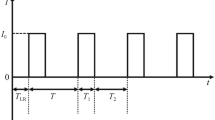Abstract
The dissolution behaviour of two different titanium alloys in aqueous electrolytes has been investigated. Therefore, a commercial titanium grade 5 (Ti90Al6V4) alloy and a self-produced Ti60Al40 alloy were compared. After preparation by arc melting and a heat treatment, an extensive characterization of the alloy by X-ray diffraction and energy-dispersive X-ray spectroscopy has been performed. The electrochemical behaviour of the alloys in different electrolytes was investigated using different techniques like linear sweep voltammetry and electrochemical impedance spectroscopy. An influence of the electrolyte composition and the titanium content of the alloy on the dissolution process could be observed. Higher titanium content of the alloy impedes the dissolution process. An increase of chloride ions in the electrolyte facilitates the dissolution. The results could be proved by an electrochemical machining (ECM) process in lab scale.













Similar content being viewed by others
References
Long M, Rack HJ (1998) Biomaterials 19:1621–1639
Rack HJ, Qazi JI (2006) Mater Sci Eng C 26:1269–1277
Wang K (1996) Mater Sci Eng A 213:134–137
Peters M, Kumpfert J, Ward C, Leyens C (2003) Adv Eng Mater 5:419–427
Boyer RR (1996) Mater Sci Eng A 213:103–114
Niinomi M (1998) Mater Sci Eng A 213:231–236
Froes FH, Suryanarayana C, Eliezer D (1992) J Mater Sci 27:5113–5140
Aspinwall DK, Dewes RC, Mantle AL (2005) CIRP Manuf Technol 54:99–104
Bhattacharyya B, Mitra S, Boro AK (2002) Robot CIM-INT Manuf 18:283–289
van Noort R (1987) J Mater Sci 22:3801–3811
de Assis SL, Wolynec S, Costa I (2006) Electrochim Acta 51:1815–1819
González JEG, Mirza-Rosca JC (1999) J Electroanal Chem 471:109–115
Lohrengel MM, Rosenkranz C, Klüppel I, Moehring A, Bettermann H, Van den Bossche B, Deconinck J (2004) Electrochim Acta 49:2863–2870
Eppelsheimer D, Perman R (1950) Nature 166:960
Downs RT, Bartelmehs KL, Gibbs GV, Boisen MB (1993) Am Mineral 78:1104–1107
Murray JL (1988) Metall Trans A 19:243–247
Schenk R (2001) The corrosion properties of titanium and titanium alloys. In: Brunette DM, Tengvall P, Textor M, Thomsen P (eds) Titanium in Medicine. Springer, Berlin Heidelberg, pp 145–170
Pan J, Thierry D, Leygraf C (1996) Electrochim Acta 41:1143–1153
Tomashov ND, Chernova GP, Ruscol YS, Ayuyan GA (1974) Electrochim Acta 9:159–172
Hefny MM, Mazhar AA, El Basiouny MS (1982) Br Corros J 17:38–41
El Basiouny MS, Mazhar AA (1982) Corrosion 38:237–240
Hirschorn B, Orazem ME, Tribollet B, Vivier V, Frateur I, Musian M (2010) J Electrochem Soc 157:C452–C457
Bannard J (1976) J Appl Electrochem 6:477–483
Rolsten RF (1968) J Appl Chem 18:292–296
Casillas N, Charlebois SJ, Smyrl WH, White HS (1993) J Electrochem Soc 140:L142–L145
Faraday M (1834) Philos Trans R Soc 124:77–122
Da Silva Neto JC (2009) Proceedings of COBEM 2009
Wang S, Zeng Y, Liu Y, Zhu D (2012) Int J Adv Manuf Technol 63:25–32
Acknowledgments
This work was financially supported by the European Union within the Interreg IV A programme “Initiative PRECISE”. We thank Prof. Dr. Rolf Hempelmann and Prof. Dr.-Ing. Dirk Bähre for fruitful discussions and Elfi Jungblut, Dipl.-Ing. Sylvia Kuhn, M. Sc. Dan Durneata, Andreas Kirsch and Dr. Nathalie Kunkel for the experimental support.
Author information
Authors and Affiliations
Corresponding author
Rights and permissions
About this article
Cite this article
Weinmann, M., Stolpe, M., Weber, O. et al. Electrochemical dissolution behaviour of Ti90Al6V4 and Ti60Al40 used for ECM applications. J Solid State Electrochem 19, 485–495 (2015). https://doi.org/10.1007/s10008-014-2621-x
Received:
Revised:
Accepted:
Published:
Issue Date:
DOI: https://doi.org/10.1007/s10008-014-2621-x




